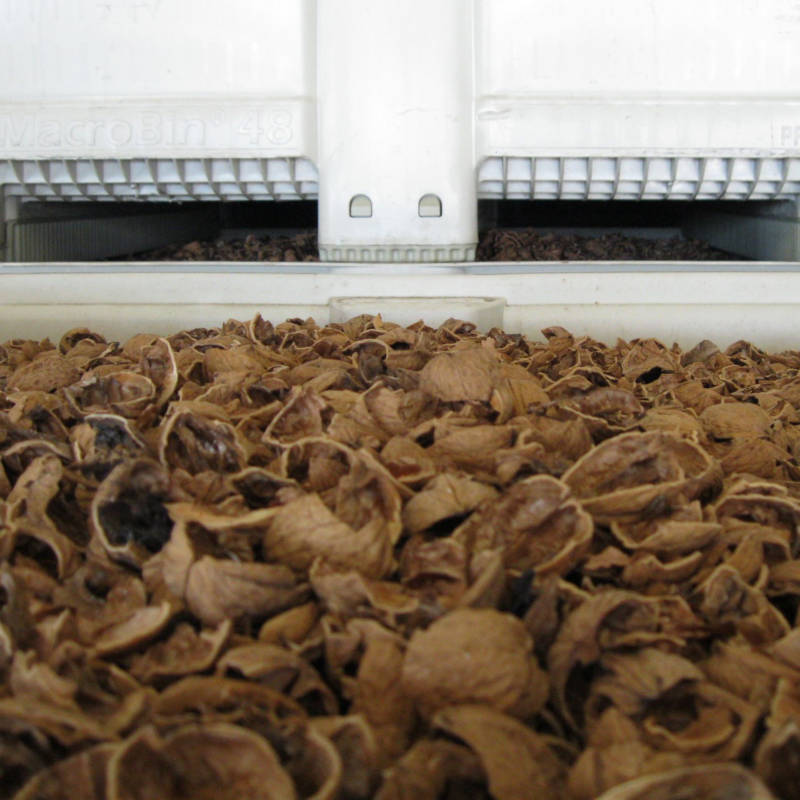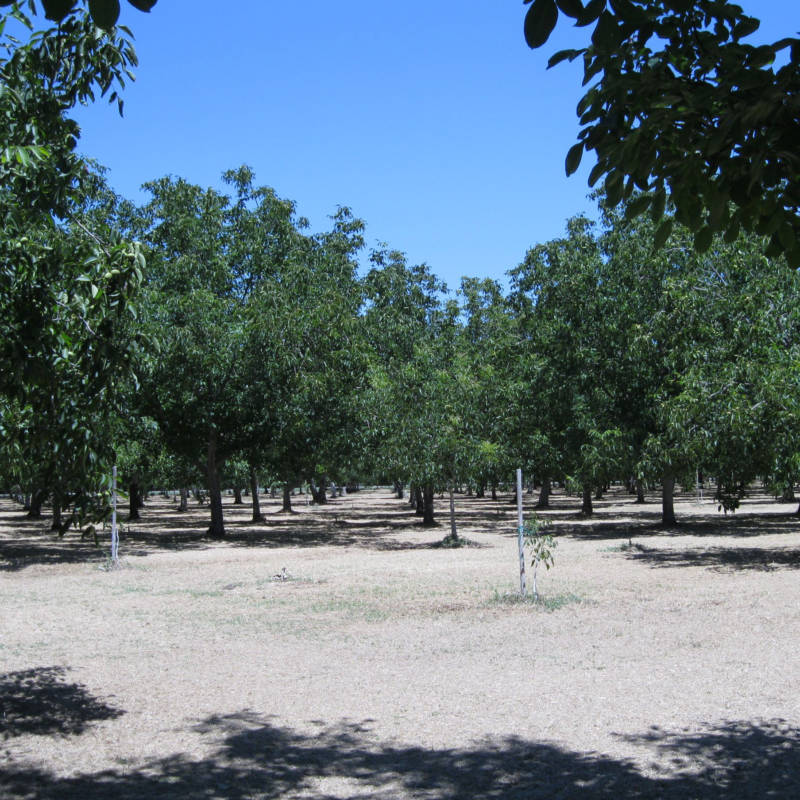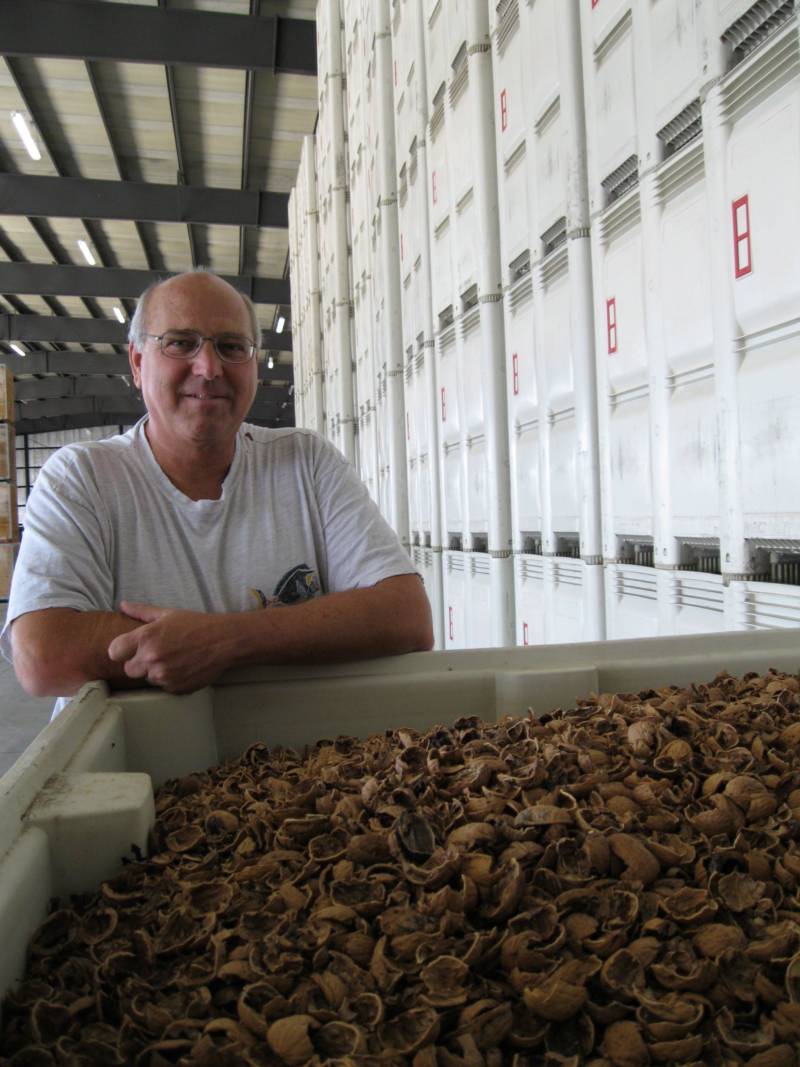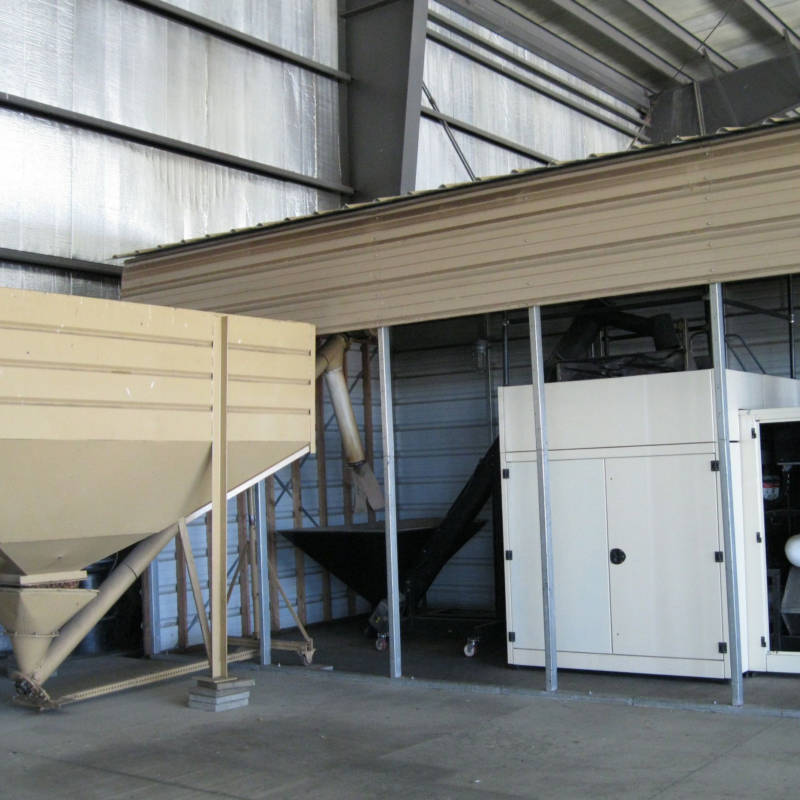
By Katrina Schwartz
California is just a few votes away from changing the rules to allow farmers to connect machines that create bioenergy to the electrical grid, a privilege that has thus far been reserved for farm-generated wind and solar energy.
Passage of the bill — SB 489 — would mean they could use the byproduct of their crops as fuel to create electricity.
Russ Lester, the owner of Dixon Ridge Farms, has been leading the charge to get the rules changed. He has gone to extraordinary lengths to shrink the carbon footprint of his organic walnut farm and processing plant in Yolo County. Brian Jenkins of the California Biomass Collaborative at UC Davis calls Lester the “guinea pig” of bioenergy.

Lester has installed a 50-kilowatt biogasifier that burns walnut shells at high temperatures to create fuel to run his generator, and heat to dry his walnuts. Lester has demonstrated his contraption to many people, including legislators, members of the California Air Resources Board and countless interested farmers. He’s been making the case for SB 489 as the only way to make this type of environmental commitment pay off for farmers. He predicts that many farmers will follow suit if state policy and regulations support farmers to use alternative energy in their businesses.
Beyond creating heat and power to become sustainable, Lester also mixes the char ash leftover from burning walnut shells into the soil where it sequesters stable forms of carbon for hundreds of years and fertilizes his walnut trees. He’s even looking into using walnut oil—another byproduct of processing—as a fuel to replace diesel to run his machinery. Lester says he’s on pace to meet his goal of being energy-neutral by 2012.
“We’re still not 100 percent,” he told me on a recent visit to the farm. “We’re probably at about 45% reduction in our energy usage, but it’s a substantial improvement. So the naysayers who say you can’t do that are really not correct.”
One of the biggest challenges Lester has faced is air quality regulation. It seems that every air quality district in California has different restrictions based on the particular challenges in that neck of the woods. So, the regulations that Lester must meet in the Yolo-Solano Air Quality District are quite different from those a farmer would face in the San Joaquin Valley Air Pollution Control District. That can pose a problem for farmers operating in districts with chronically bad air quality as any emissions they create will be closely watched.
Kevin Hall, a co-founder of the Central Valley Air Quality Coalition, says he supports efforts by farmers to produce renewable energy, but he’s wary of the potential effect on air quality. As long as producers like Lester keep their systems under the one-megawatt limit set out in SB 489, says Hall, it shouldn’t be a problem. It’s conceivable that many small growers could produce the same amount of pollution as a large power plant if they aren’t regulated. Very few California farmers have a biogasifier like Lester’s, so Hall isn’t too concerned just yet.

The biggest opposition to SB 489 comes from utilities. In its opposition letter, PG&E claimed that net-metering (allowing sale-back to the grid) of all renewables would cost the average ratepayer more. The California Public Utilities Commission found the opposite in its analysis [PDF]; that SB 489 would likely reduce the cost to the average consumer. That’s because farmers and commercial consumers of electricity already pay some costs that residential consumers don’t, like the cost to distribute and transmit the power. Those embedded fees make net metering for bioenergy less expensive than net metering for residential solar. PG&E’s numbers are based on the performance of solar net metering.
The other problem utilities point to is the net-metering cap. Right now, utilities buy no more than five percent of their peak energy load through the net-metering program. If more types of technology are eligible for the program, that could mean reaching the cap more quickly. If that happens, legislators might be tempted to raise the cap. For utilities, that would mean managing lots of small producers instead of a few big ones. Nor does the energy produced through net metering count towards the utilities’ state-mandated renewable energy targets. Right now, no utility is close to reaching the cap. Most are still buying less than two percent of their power from net metering.

Supporters of SB 489 are close to reaching their goal. The bill has a broad range of environmental and agricultural supporters, including the California Climate and Agriculture Network (CalCAN) and the California Farm Bureau Federation. It won significant bipartisan support as it moved through various committees in both the Senate and the Assembly. The next hurdle will be a full Assembly vote and another full Senate vote to reconcile some small changes. Senate sponsor Lois Wolk (D-Stockton) says Governor Jerry Brown has been supportive of the bill and that if it gets to his desk before the end of the legislative year on September 9th, he’s likely to sign it.
8 thoughts on “Making Renewable Energy from Farm Waste”
Comments are closed.

Cornell Prof, D. Pimentel and T Patzek, professor of environmental engineering at Berkeley, did an analysis of the energy input-yield ratios of producing ethanol from corn, switch grass and wood biomass as well as for producing biodiesel from soybean and sunflower plants. Their report is published in Natural Resources Research (Vol. 14:1, 65-76).
In terms of energy the study found that:
corn requires 29 percent more fossil energy than the fuel produced;
switch grass requires 45 percent more fossil energy than the fuel produced; and
wood biomass requires 57 percent more fossil energy than the fuel produced.
In terms of energy output from biodiesel production, the study found that:
soybean plants requires 27 percent more fossil energy than the fuel produced
sunflower plants requires 118 percent more fossil energy than the fuel produced.
In assessing inputs, the researchers considered such factors as the energy used in producing the crop (including production of pesticides and fertilizer, running farm machinery and irrigating, grinding and transporting the crop) and in fermenting/distilling the ethanol from the water mix. Although additional costs are incurred, such as federal and state subsidies that are passed on to consumers and the costs associated with environmental pollution or degradation, these figures were not included in the analysis.
Concluding, Pimentel said, “but producing ethanol or biodiesel from plant biomass is going down the wrong road, because you use more energy to produce these fuels than you get out from the combustion of these products.”
for details of above exerpts from this article:
http://www.news.cornell.edu/stories/july05/ethanol.toocostly.ssl.html
This response based heavily on liquid fuels has nothing to do with this article on the use of walnut shells to make electricity.
In response to G Kaplans comment.
I could be wrong, but it seems those studies assume that the crop is produced only for the production of ethanol (true for corn etc). Walnut shells however are a waste item from the production of walnuts for consumption. Therefore to count the costs of harvest, irrigation, etc would be in economic terms “double dipping.” The only costs that should be included are the additional costs once the nuts have been removed from the shells, and the processes that turn the shells into energy.
Great article! Anyone with an interest in this topic should join us on Sept 13-14 in Sacramento for the annual California Bio-Resources Alliance Symposium.
The legislation is to allow farmers to use biomass for energy production. The photo of the shells from various walnuts is just One of the innumerable examples of what is considered biomass. Again, not only is biomass fuel inefficient, but it continues to escalate our CO2 accumulation, which is a cumulative process, that will precipitate further the global warming we are trying to curb!
Enclosed are a couple articles, and a law suit filed because burning biomass is not a “safe and clean type of energy. As a matter of fact, burning biomass produces more C02 than coal !
Here is a report from PARTERNNSHIP FOR POLICY INTEGRITY:
CARBON EMISSIONS FROM BURNING BIOMASS FOR ENERGY.
Is biomass “Worse than coal”? Yes, if you’re interested in reducing carbon dioxide emissions anytime in the next 40 years
Burning biomass emits more CO2 than fossil fuels per megawatt energy generated:
1. Wood inherently emits more carbon per Btu than other fuels
Natural gas: 117.8 lb CO2/mmbtu
Bituminous coal: 205.3 lb CO2/mmbtu
Wood: 213 lb CO2/mmbtu (bone dry)
( one can consider nut shells in same category as wood.
The bottom line: unlike other renewable energy technologies like wind and solar, biomass is a perpetual emitter, meaning that every year’s fuel supply requires creating a new “carbon debt”.
http://www.pfpi.net/carbon-emissions
Here is a sample of law suits about this situation:
Five groups sue over EPA’s cave-in to industry on #biomass CO2, stating EPA has ignored the science. http://t.co/kZjzKJH
Eoeea study reports burning biomass can not be compared to solar or wind clean fuels, and confirms these produce C02 of levels that are unacceptable.
http://www.mass.gov/Eoeea/docs/doer/renewables/biomass/Manomet_Biomass_Report_ExecutiveSummary.pdf
At the rate we are going, there be a day when we wise up and realize what petrochemicals have done to our health, economy and ecology ( this applies to biofuels) and WE the People, will sue these culprits, same as dying lung cancer patients sued the tobacco companies.
Voting YES for using biofuels for fuel, knowing these fuels are not only of no value, but destructive to our biosphere ( except for farmers profit ) is unconscionable.
The photo of the shells from various walnuts is just One of the innumerable examples of what is considered biomass. Again, not only is biomass fuel inefficient, but it continues tO EESCALATE C02 which is a cumulative process, AND precipitate the global warming we are trying to curb!
As a matter of fact, burning biomass ( THIS INCLUDES ANY SHELLS, WOOD, ETC,PRODUCES MORE C02 THAN COAL! !
Here is a report from Ppartnership for Policy Integrity:
I”s biomass “Worse than coal”? Yes, if you’re interested in reducing carbon dioxide emissions anytime in the next 40 years. Burning biomass emits more CO2 than fossil fuels per megawatt energy generated:
1. Wood inherently emits more carbon per Btu than other fuels
Natural gas: 117.8 lb CO2/mmbtu
Bituminous coal: 205.3 lb CO2/mmbtu
Wood: 213 lb CO2/mmbtu (bone dry)
( nut shells are in same category as wood.) Best be utilized for wood boards, if crushed.
The bottom line: unlike other renewable energy technologies like wind and solar, biomass is a perpetual emitter, meaning that every year’s fuel supply requires creating a new “carbon debt”.
http://www.pfpi.net/carbon-emissions
Here is a sample of law suits about this situation:
Five groups sue over EPA’s cave-in to industry on #biomass CO2, stating EPA has ignored the science. http://t.co/kZjzKJH
Eoeea study reports burning biomass can not be compared to solar or wind clean fuels, and confirms these produce C02 of levels that are unacceptable.
http://www.mass.gov/Eoeea/docs/doer/renewables/biomass/Manomet_Biomass_Report_ExecutiveSummary.pdf
At the rate we are going, there be a day when we wise up and realize what petrochemicals have done to our health, economy and ecology ( this applies to biofuels)
Remember, a great deal of soil loss due to erosion is due to farming techniques that do not plow into the soil the old biomass, which is critical for plant nutrition.
Voting YES for using biofuels for fuel, knowing these fuels are not only of no value, but destructive to our biosphere ( except for farmers profit ) is unconscionable
I don’t quite understand the POV of this article. He’s only producing 45% of his energy usage but wants to connect to the grid to sell energy? Farmers should take care of on-farm energy requirements before selling to the grid. Otherwise we risk farms turning into huge energy producing facilities as opposed to food production facilities. Once farmers can run power plants, the economy of scale in agriculture is allowed to increase once again due to incentive for production. Do we really want huge energy farms? I’d like to see this farmer produce his own diesel fuel before trying to sell electricity to the grid.
Gabriella: I understand your concern. However, please know that this law would only apply to small-scale renewable energy projects that qualify under net-metering – up to 1 MW. The type of biogas or ethanol production you are discussing would fall into a different league with different rules. Also, this law does not supersede any clean air regulation. Producers still must comply with their local air district’s regulations. I am not sure where you are getting your data and if it is California based at all, but here in California we have very strict regulations. Most air districts don’t allow the type of wood burning you are describing – even in households.
GT: The goal is to be exactly at 100%, however it is very difficult to do so if you do not have access to the grid as a “battery”. If you have ever looked at your meter, you will notice that energy usage is not stagnant; it fluctuates. Without the grid as a battery, one can only produce enough energy for the lowest energy use in a given day or else you will blow your circuits. The BioMax only can produce at 80% of peak because of these fluctuations.